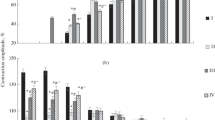Abstract
Myocardial damage was studied in the dog heart with experimentally induced myonephropathic metabolic syndrome (MNMS). The animals underwent a ligation of the infrarenal arteries with a re-establishment of arterial flow 5 hours after the operation (group 1) and all showed the typical phenomena of MNMS and revealed basophilic changes in the myocardial cells fixed with 4 per cent formalin in 2 per cent calcium acetate. These degenerated cells were distributed in either the left or right ventricle, or even in both as several foci composed of a considerable number of the myocardial cells. Most of these cells showed a significantly enhanced expression of immunoreactive copper-zinc superoxide dismutase in their sarcoplasm. With luxol fast blue staining, the basophilic myocardial cells appeared to be deep blue in color which indicated an accumulation of phospholipid. Such basophilic cells in the animals undergoing a sham operation (group 2) were only sporadically observed in the myocardium fixed with the same fixative. The present study including morphological procedures indicates that dog MNMS causes severe myocardial damage with superoxidation due to an excessive production of free radicals after the re-establishment of arterial flow.
Similar content being viewed by others
References
Haimovici H (1960) Arterial embolism with acute massive ischemic myopathy and myoglobinuria. Surgery 47:739–747
Haimovici H (1970) Arterial embolism, myoglobinuria, and renal tubular necrosis. Arch Surg 100:639–645
Haimovici H (1973) Myopathic-nephrotic-metabolic syndrome associated with massive arterial occlusions. J Cardiovasc Surg 14:589–600
Haimovici H (1979) Muscular, renal and metabolic complications of acute arterial occlusions. Myonephropatic-metabolic syndrome. Surgery 85:461–468
Larcan A, Mathieu P, Helmer J, Fieve G (1973) Severe metabolic changes following delayed revascularization: Legrain-Cormier syndrome. J Cardiovasc Surg 14:609–614
Bugge M, Jelenes R, Arendrup H (1985) Arterial embolism of the legs A follow up study of 252 patients. Ann Chir Gynaecol 74:137–141
Provan JL, Fraenkel GJ, Austin WG (1966) Metabolic and hemodynamic changes after temporary aortic occlusion in dogs. Surg Gynecol Obstet 123:544–550
Esato K, Nakano H, Ohara M, Nomura S, Mohri H (1985) Methods of suppression of myonephropathic metabolic syndrome. J Cardiovasc Surg 26:473–478
Takasaki H, Shirabe J, Hadama T, Tanaka K, Mori Y, Oka K, Kawawaki Y, Uchida Y, Nakayama I, Murakami S, Kuroda T, Umegaya M (1988) Experimental evaluation of removal of myoglobin in case of MNMS. (in Japanese with English Abst.) Jinkouzouki (Jpn J Artif Organs) 17:297–301
Kano N (1983) Metabolic study on acute arterial occlusion of the extremities. (in Japanese with English Abst.) Nippon Geka Gakkai Zasshi (J Jpn Surg Soc) 84:161–174
Kontaxis AN, Skalkeas Gr, Sechas M, Georgiadou D, Arealis E (1973) Effect of acute arterial ischemia of the extremities on cardiac and pulmonary functions. J Cardiovasc Surg 14:605–608
Ikezawa T (1989) An experimental study of tissue injury associated with reperfusion in ischemic limbs. (in Japanese with English Abst.) Nippon Geka Gakkai Zasshi (J Jpn Surg Soc) 90:1799–1805
Fisher RD, Fogarty TJ, Morrow AG (1970) Clinical and biochemical observations of the effect of transient femoral artery occlusion in man. Surgery 68:323–328
Takasaki H, Hadama T, Matsushima R, Watanabe S, Shirabe J (1990) Extracorporeal circuration for removal of serum myoglobin in experimentally induced myonephropathic metabolic syndrome in the dog. Jpn J Surg (in press)
Thaete LG, Crouch RK, Shulte BA, Spicer SS (1983) The immunolocalization of copper-zinc superoxide dismutase in canine tissues. J Histochem Cytochem 31:1399–1406
Thaete LG, Crouch RK, Spicer SS (1985) Immunolocalization of Cu-Zn superoxide dismutase in striated muscle. Histochemical J 17:259–262
Puchtler H, Waldrop FS, Conner HM, Terry MS (1968) Carnoy fixation: Practical and theoretical considerations. Histochemie 16:361–371
Guesdon JL, Ternynck T, Avrameas S (1979) The use of avidinbiotin interaction in immunoenzimatic techniques. J Histchem Cytochem 27:1131–1139
Korthuis RJ, Grnger DN, Townsley MI, Taylor AE (1985) The role of oxygen-derived free radicals in ischemia-induced increases in canine skeletal muscle vascular permiability. Circ Res 57:599–609
Granger DN, Rutili G, McCord JM (1981) Superoxide radicals in feline intestinal ischemia. Gastroentrogy 81:22–29
McCord JM (1985) Oxygen-derived free radicals in postischemic tissue injury. N Engl J Med 312:159–163
Babior BM, Kipnes RS, Curnutte JT (1973) Biological defence mechanisms. The production by leukocytes of superoxide, a potential bactericidal agent. J Clin Invest 52:741–744
Petrone WF, English DK, Wong K, McCord JM (1980) Free radicals and inflamation: Superoxide-dependent activation of a neutrophil chemotactic factor in plasma. Proc Natal Acad Sci USA 77:1159–1163
Nohl H (1986) Oxygen radical release in mitchondria. In: Johnson JE ed. Influence of age. Free radicals, aging, and degenerative diseases. New York: Alan R Liss 77–97
Yoshizawa T, Ichikawa H, Kondo M (1990) Ischemia-reperfusion injury and free radicals. (in Japanese with English Abst.) Kasseisanso furiirajikaru (J Act Oxyg Free Rad) 1:258–262
Nishigaki I, Hagihara M, Hiramatsu M, Izawa Y, Yagi K (1980) Effect of thermal injury on lipid peroxide levels of rat. Biochem Med 24:185–189
Weisiger RA, and Fridvich I (1973) Mitochondrial superoxide dismutase. Site of synthesis and intramitchondrial localization. J Biol Chem. 248:4793–4796
Marklund SL, Holme E, and Hellner L (1982) Superoxide dismutase in extraceluller fluids. Clin Chem Acta. 126:41–51
Nakayama F, Akizawa T, Kinugasa E, Kitaoka T, Koshikawa S, Nakabayashi N, Yamawaki N, Kuroda T (1988) Removal of β2-microglobulin by direct hemoperfusion with a newly developed absorbent. (in Japanese with English Abst.) Jinkouzouki (Jpn J Artif Organs) 17:751–755
Author information
Authors and Affiliations
Rights and permissions
About this article
Cite this article
Watanabe, S., Hadama, T., Takasaki, H. et al. Myocardial damage caused by free radicals in experimentally induced myonephropathic metabolic syndrome in dogs. Surg Today 22, 55–61 (1992). https://doi.org/10.1007/BF00326126
Received:
Issue Date:
DOI: https://doi.org/10.1007/BF00326126



